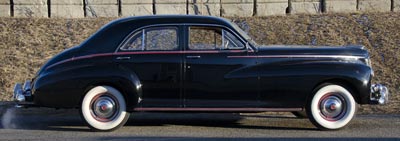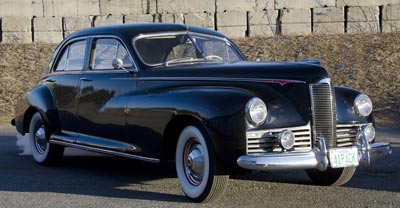

The 19th series Packard Clipper began production in 1941 as a four-door sedan on a newly designed chassis. The 127-inch wheelbase was the same as the concurrently offered One-Twenty model, but featured a wider stance and lower height than any previous Packard. The Clipper’s streamlined envelope body style, combined with the traditional Packard elements; long hood line, raked back split windshield and arched radiator defined the Packard body style until 1950.
The 19th series Clippers were powered by the same 282 cubic inch, straight-eight engine offered in the One-Twenty model, producing 125hp. With over 40 different models to choose from and a beautiful new streamlined Clipper body to draw customers into their showroom, Packard was poised for growth. Pearl Harbor and the military rise of Germany put that on hold.
Due to the war effort, 1942 saw limited production of the 20th series. The Clipper lineup expanded to 2-door club sedans, and the one-sixty super-eight models. Horsepower was increase to 165hp with the 356 cubic inch, straight eight. Only 2580 units were produced in 1942.
During WW II the Packard factory produced 55,873 Rolls-Royce Merlin engines for the US Air Force, P-51 Mustang fighter plane as well as variety of British planes. These 1649cubic inch, 1600hp, V-12 engines helped the allies win the War. More info on this topic here.
After the war the 21st series Packards began to roll out of Detroit and the entire model line was made up of 13 different Clipper models. Very few changes were made to the 1942 design. Junior cars were produced on a 120-inch wheelbase and were powered by a 245 cubic inch inline six, producing 105 hp or the 282ci-8 rated at 125hp. The Super and Custom Super Clipper, senior Packards were built on the 127 or 148-inch wheelbase and powered by the ultra smooth 356 cubic inch, in-line, eight producing 165 hp. Their horizontal grill extensions wrapped around the front fenders helping distinguish them from the lower priced models.
The Classic Car Club of America (CCCA), designated the 1946–47 Super and Custom Super Clipper, “classic” car status, the only postwar Packard so recognized.

